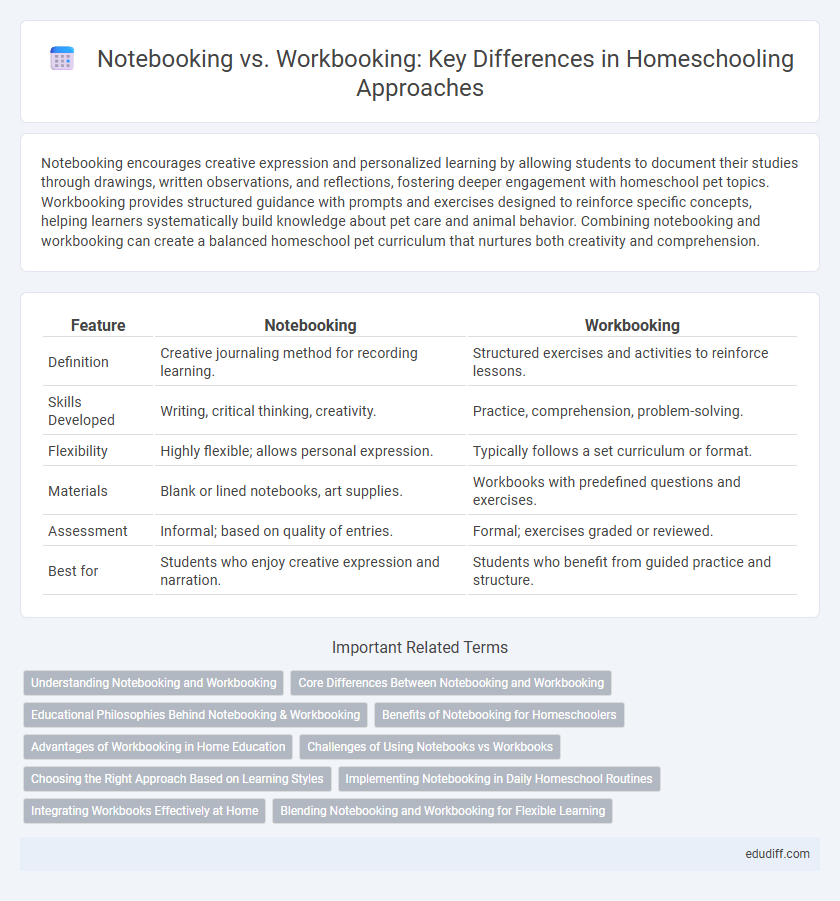Notebooking encourages creative expression and personalized learning by allowing students to document their studies through drawings, written observations, and reflections, fostering deeper engagement with homeschool pet topics. Workbooking provides structured guidance with prompts and exercises designed to reinforce specific concepts, helping learners systematically build knowledge about pet care and animal behavior. Combining notebooking and workbooking can create a balanced homeschool pet curriculum that nurtures both creativity and comprehension.
Table of Comparison
| Feature | Notebooking | Workbooking |
|---|---|---|
| Definition | Creative journaling method for recording learning. | Structured exercises and activities to reinforce lessons. |
| Skills Developed | Writing, critical thinking, creativity. | Practice, comprehension, problem-solving. |
| Flexibility | Highly flexible; allows personal expression. | Typically follows a set curriculum or format. |
| Materials | Blank or lined notebooks, art supplies. | Workbooks with predefined questions and exercises. |
| Assessment | Informal; based on quality of entries. | Formal; exercises graded or reviewed. |
| Best for | Students who enjoy creative expression and narration. | Students who benefit from guided practice and structure. |
Understanding Notebooking and Workbooking
Notebooking emphasizes creative expression and personalized learning through journaling, drawing, and compiling information, helping students develop critical thinking and retain knowledge. Workbooking involves structured exercises and guided practice in worksheets or workbooks, promoting skill mastery and reinforcement of specific concepts. Understanding the balance between notebooking and workbooking allows homeschoolers to tailor educational approaches to individual learning styles and objectives.
Core Differences Between Notebooking and Workbooking
Notebooking emphasizes creative expression and personalized learning through open-ended journaling, drawing, and scrapbooking, fostering deep engagement and critical thinking. Workbooking relies on structured, guided exercises and worksheets designed to reinforce specific skills and knowledge, providing measurable progress and consistent practice. Core differences lie in notebooking's flexibility and learner-driven approach versus workbooking's systematic, teacher-directed format focused on standard objectives.
Educational Philosophies Behind Notebooking & Workbooking
Notebooking aligns with constructivist educational philosophies, emphasizing student-driven learning, creativity, and the integration of personal reflections to deepen understanding. Workbooking reflects a more structured, behaviorist approach, focusing on guided practice, repetition, and mastery of specific skills through organized exercises and assessments. These differing philosophies impact how knowledge is processed and retained in homeschool environments.
Benefits of Notebooking for Homeschoolers
Notebooking enhances homeschool learning by promoting active engagement and personalized expression of knowledge, allowing students to document lessons creatively and retain information effectively. It supports diverse learning styles through flexible formats such as drawings, diagrams, and written reflections, fostering deeper understanding and critical thinking skills. Compared to traditional workbooking, notebooking encourages ownership of learning and boosts motivation by transforming education into a dynamic, student-centered process.
Advantages of Workbooking in Home Education
Workbooking in home education offers structured guidance through step-by-step instructions and built-in exercises, ensuring consistent skill development and clear learning objectives. It simplifies lesson planning for parents by providing ready-made materials aligned with curriculum standards, reducing preparation time and stress. This method promotes accountability and measurable progress, making it easier to track student achievement and adjust teaching strategies accordingly.
Challenges of Using Notebooks vs Workbooks
Using notebooks in homeschool settings often presents challenges such as the need for consistent organization and self-discipline, which can overwhelm students lacking strong time-management skills. Workbooks provide structured guidance but may limit creativity and adaptability, making it difficult for learners to engage deeply with the material. Balancing the open-ended nature of notebooking with the rigidity of workbook exercises requires careful consideration of individual learning styles and educational goals.
Choosing the Right Approach Based on Learning Styles
Notebooking allows for creative expression and personalized reflections, ideal for visual and kinesthetic learners who benefit from writing and drawing. Workbooking provides structured exercises and guided questions, better suited for logical and sequential learners who prefer clear instructions and incremental progress. Selecting the right approach depends on understanding a child's unique learning style to enhance engagement and retention in a homeschool environment.
Implementing Notebooking in Daily Homeschool Routines
Implementing notebooking in daily homeschool routines enhances student engagement by encouraging creativity and personalized learning documentation. Unlike traditional workbooking, which often follows rigid templates, notebooking allows children to capture ideas through drawings, written reflections, and hands-on activities, making learning more meaningful and memorable. Integrating notebooking consistently supports skill development in critical thinking, organization, and self-expression, fostering a deeper connection with the curriculum.
Integrating Workbooks Effectively at Home
Integrating workbooks effectively at home involves using them as structured guides while complementing notebooking to foster creativity and critical thinking in homeschool settings. Workbooks provide clear, sequential lessons and exercises that reinforce specific skills, whereas notebooking encourages personal reflection and deeper understanding through customizable content. Balancing both methods enhances learning retention by combining workbook discipline with the flexibility and engagement of notebooking.
Blending Notebooking and Workbooking for Flexible Learning
Blending notebooking and workbooking creates a flexible learning environment in homeschool settings by combining creative expression with structured practice. Notebooking fosters critical thinking and personalized documentation, while workbooking ensures mastery of specific skills through guided exercises. Integrating both methods allows students to engage actively with material, balancing creativity and systematic learning for comprehensive educational development.
Notebooking vs Workbooking Infographic

 edudiff.com
edudiff.com